Engineering Encounters
Extending Engineering Learning Beyond Field Trips
Science and Children—September/October 2020 (Volume 58, Issue 1)
By Alexandria Muller, Tarah Connolly, Ron Skinner, and Danielle Harlow
While school field trips are valued as supplementary educational tools, Andersen and Zhang (2003) found that in practice field trips are often treated as one-off learning experiences and not furthered through connections to the classroom curriculum. Although students gain exposure to new phenomena and are able to participate in learning activities involving resources not typically available at schools, the short time constraint of a field trip limits the depth of the learning experience. We worked with local K–6 teachers to develop lesson plans that would connect a 50-minute engineering design challenge, completed during a field trip to MOXI, The Wolf Museum of Exploration + Innovation, to the students’ classroom learning. The result was a model for designing pre-visit classroom activities that develop students’ familiarity with phenomena, tools, and processes that will be used during the field trip and post-visit classroom activities that provide students with opportunities to reflect on some of their field trip experiences. While the field trip activity alone is an exciting and productive learning opportunity, students who complete the full set of classroom and field trip activities participate in a richer experience that engages them in more of the practices of science and engineering and more fully develops the disciplinary core ideas related to engineering and physical science.
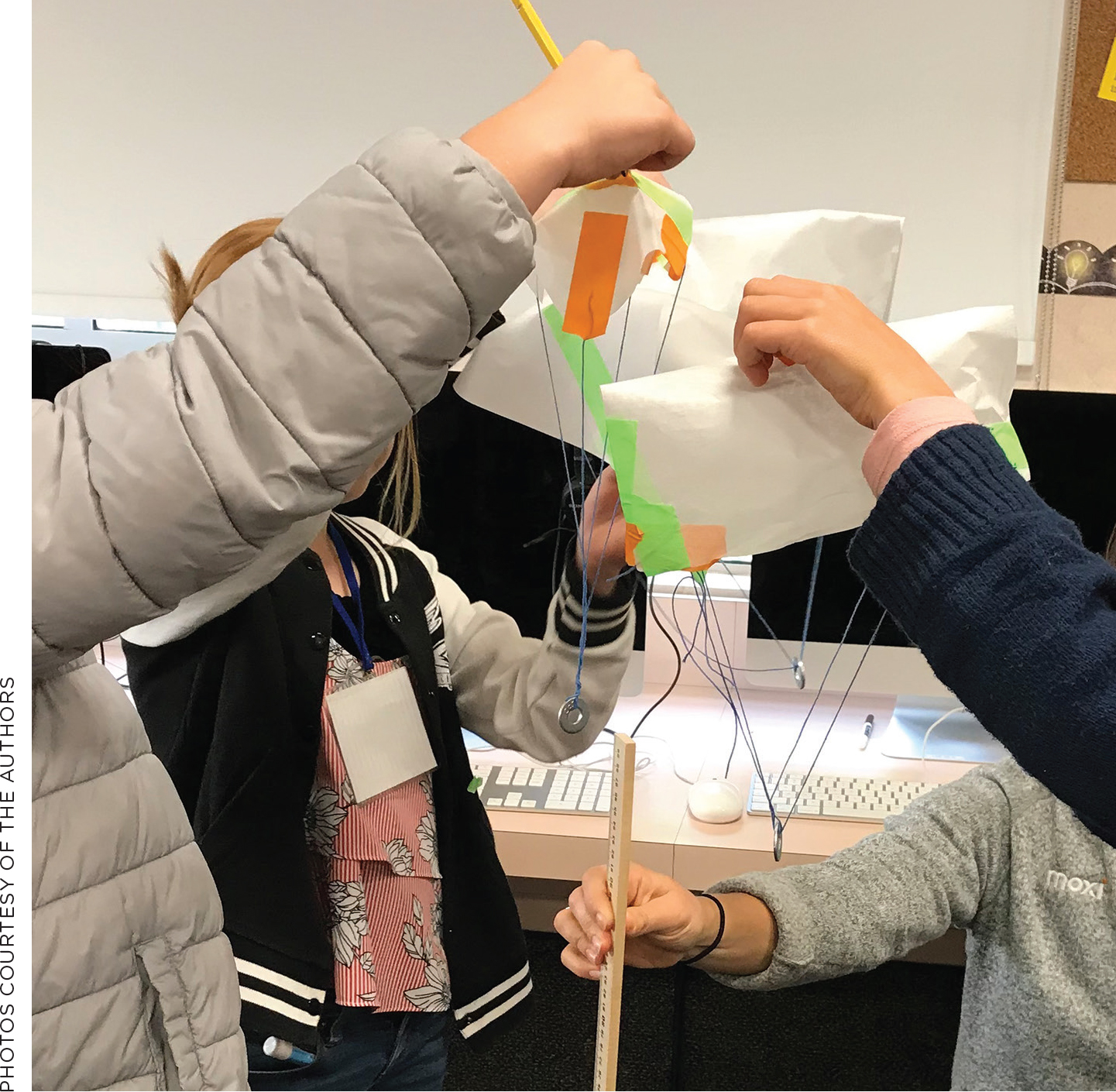
Students test their devices.
Each Engineering Exploration module includes four activities: an engineering design activity completed during a field trip to an interactive science museum, accompanied by two pre-activities and one post activity done in students’ classroom and facilitated by their elementary school teacher. While each classroom activity was designed to take no more than 50 minutes, many teachers found it valuable to extend each lesson to allow for deeper discussion and engagement with the activities. For more detailed information around the module development, please see Harlow et al. 2020.
The classroom experiences presented here are associated with a field trip program in which students iteratively design a craft out of paper and tape that will hover above a “fire” (upward moving column of air) while carrying a “sensor” (washer). The classroom activities surrounding this field trip help students develop conceptual understandings of forces to navigate the engineering design challenge. Early iterations of this curriculum were tested as an outreach program with three first-grade classes, three third-grade classes, and two sixth-grade classes. The curriculum was then piloted in classrooms by three third-grade teachers and two fourth-grade teachers. The activities presented here focus on the third- and fourth-grade levels, but for more information about how to adapt them for younger or older grades see Muller et al. (2019).
Classroom Activity 1
To introduce the activity, the teachers showed the students a parachute made from deli paper, string, tape, and a washer and asked students to make predictions about what they thought would happen when the parachute was dropped. Students made predictions such as “it will fall” or “the metal [washer] will pull it down.” The teacher dropped the parachute and students voiced their observations (and some preliminary inferences) such as “it fell because of gravity” or “it went fast.” To elicit more ideas about forces in motion, the teachers expanded the discussion by asking questions such as: What do you think is making the parachute fall? What happened that made the parachute fall slowly? What do you notice about how the parachute moved/opened up?
The teachers then focused students’ attention on the design of the parachute by asking for observations about the materials of the parachute and by asking questions such as, “How could you change the design of the parachute?” Answers included changing the color of the canopy, length of the string, and shape or size of the canopy. The class discussed isolating variables and focused in on the size of the canopy. The teacher asked, “Will a small, medium, or large parachute fall the slowest?”
Students worked in teams to construct three different square parachutes (4in/10cm, 8in/20cm and 12in/30cm) using deli paper (similar to packing paper, can be purchased on Amazon or at local craft store), string, tape, and a ¼-inch washer. If you do not have access to deli paper and washers, some alternative materials for the parachute include printer paper, newspaper, tissue paper, or plastic bags and alternatives for the washer include pennies or small plastic dinosaurs (ensuring that the same materials are used across all activities).
Students predicted which parachute would fall the slowest, explained the reasoning behind their prediction, and recorded both their prediction and reasoning on a handout (Figure 1). The teams then tested each parachute by dropping all three at the same time from equal heights (1 meter) and recording which parachute landed last on their data sheet. After 10 trials, the students converted their data into a bar graph and, as a whole class, discussed any differences in their data between groups and any patterns they noticed.
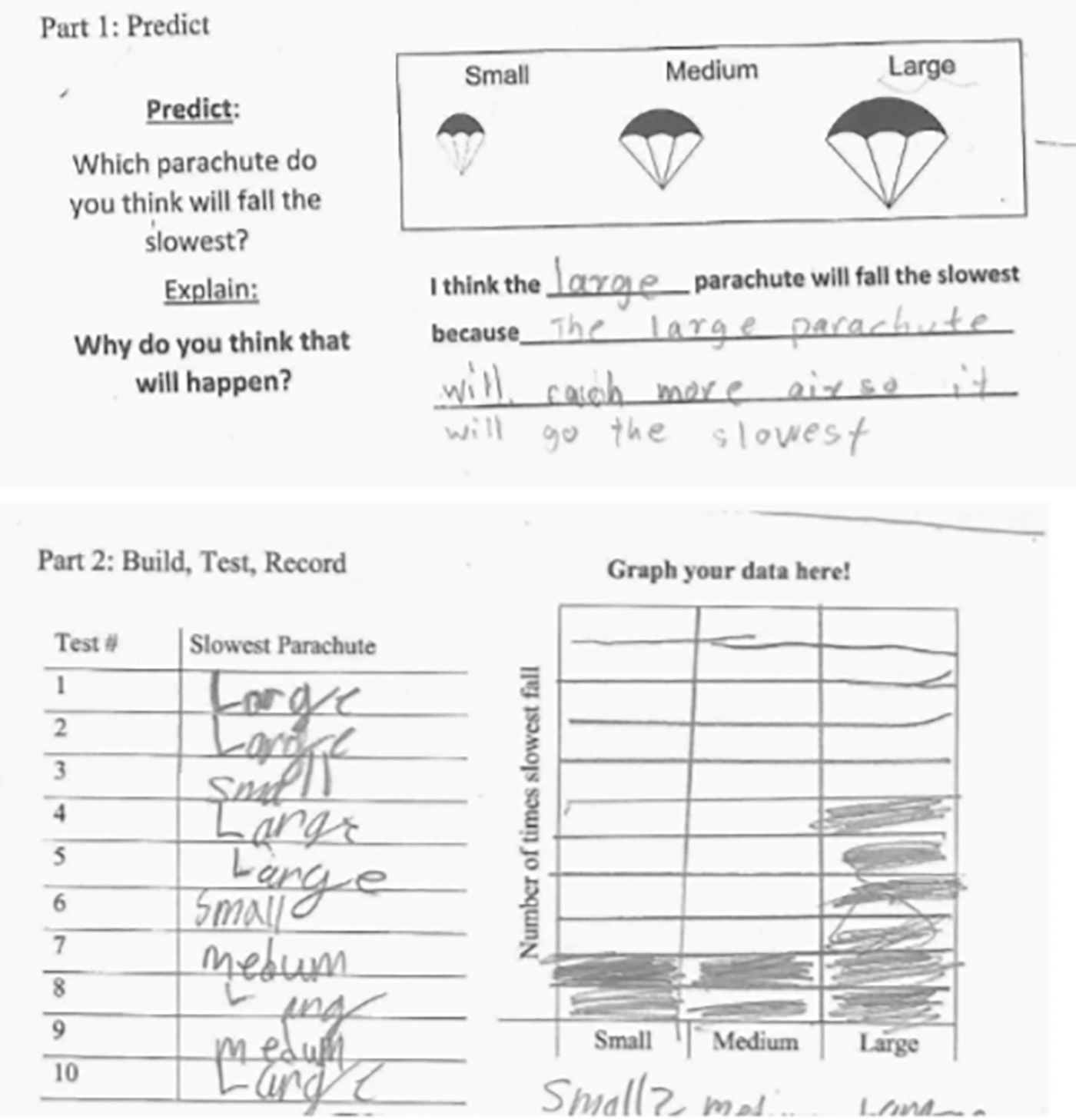
Student predictions and data sheet.
The teachers then connected the discussion about the data back to the initial research question and discussed with students what they thought caused the larger parachute to take longer to fall. One student responded that “the larger one catches more air than the medium and smaller, which makes it go slower than the medium and smaller ones.” Students’ ideas were expanded upon by the teacher to emphasize that the surface area of a parachute impacts the rate of fall.
Classroom Activity 2
The second classroom activity, which also preceded the field trip, introduced the engineering design process while further building upon the idea of forces. After reflecting upon the first classroom activity and reiterating the relationship between surface area and the rate of fall of a parachute, the teachers introduced the engineering design challenge for the day: to design and construct a craft that can carry a washer as slowly as possible to the ground. They emphasized the criteria and constraints of this design challenge with the criteria being that the craft had to fall slower than a plain washer, and the constraints being limited materials (paper and tape) and time (i.e., they had to develop the best design before the end of the lesson).
Students worked individually to design their first craft and sketched their ideas (Figure 2). These designs ranged from parachutes to boxes and flat sheets of paper. One girl stated, “I think we could use a box to catch the air…and make it slow falling.” Once the students finished their first design, they created and tested the designs against a free-falling washer to see if their design fell slower. Similar to the first activity, the teachers emphasized the importance of multiple trials and keeping the variables like height constant when testing their designs.
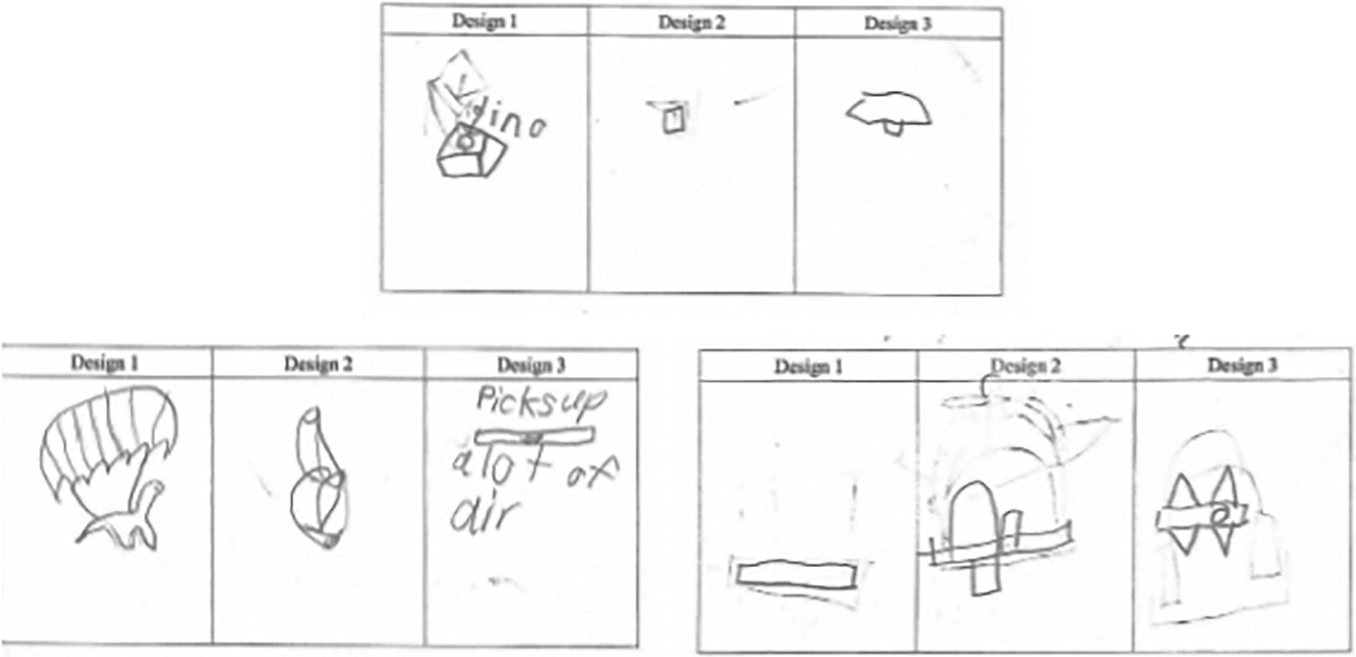
Student designs.
The teachers led a whole-class discussion about what did and did not work in students’ first designs. Sentence starters such as, “our design could be made better if we ________ because ___________” or “My design worked well because ___________” may be used to help guide student participation. After the discussion, students assembled into small groups to combine the elements of their individual designs into one group design. After the groups designed their craft, each individual student made a prototype of the craft using the same “group design” resulting in three or four similar crafts to test. The students then performed a drop test comparing this new design to a plain washer. After the drop test, the teachers guided students to think about the changes they made and how these changes impacted the performance of the crafts. Students noted which designs “picked up air” and identified them as successful craft designs.
Finally, students worked individually to develop their own designs based on the previous two. Starting with a sketch and progressing toward development and testing against a plain washer, students’ designs had evolved with some students flattening out their designs, while others turned toward designs they associated with flight such as paper airplanes. The teachers concluded the lesson by having several students share their initial and final designs and commenting about how these designs evolved. Probing questions to start the discussion included, What did they notice between iterations? Why did they make the changes they did? How did working in a group influence their design process? Additionally, the teachers reviewed the engineering design process as outlined by the Next Generation Science Standards (NGSS) by discussing and identifying the various stages of the engineering design process throughout their craft development (NGSS Lead States 2013). One teacher connected their craft design to other engineering design tasks that had been completed earlier in the year to expand upon students’ preexisting understanding of the engineering design process.
Field Trip Activity
After completing the first two activities in their classroom, students attended a field trip to an interactive science museum to participate in an engineering design activity. The field trip activity focuses on a real-world design challenge that provides students opportunities to apply their knowledge from the classroom activities without requiring them. Students started off by discussing an image of a local fire, a phenomenon familiar to the students in central California, where wildfires are a common occurrence. The museum facilitators guided the discussion to focus on what firefighters would need to learn about the fire in order to successfully fight it as well as how they would be able to gain this information. Tying together the observation that the cloud of smoke appeared to be rising and students’ ideas of flying over the fire to measure it lead to the presentation of the engineering design challenge: to design and develop a craft to hold a washer-sized sensor that would hover over a fire. Students were provided with the same materials as the classroom activities (paper, tape, and scissors) with the addition of hole punchers to develop their designs; however, rather than performing a drop test like they did in the classroom, students individually tested their designs in a wind column that modeled the rising air of the fire with the goal of hovering rather than falling the slowest (Figure 3). At the end of this activity, the students discussed their development process and drew a “blueprint” (detailed drawing) of their final design to be used in the final classroom activity.
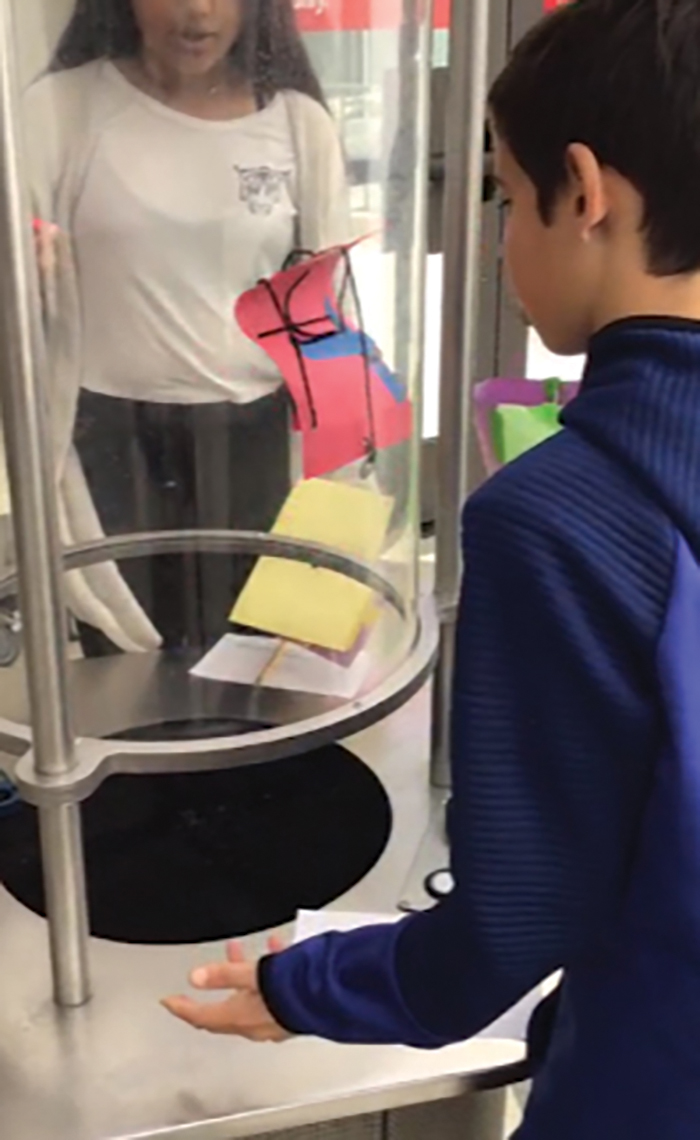
Students test their designs.
Classroom Activity 3
For the post-activity in the classroom, students reflected and expanded upon the previous three activities. The teachers started with a discussion about what each activity was and what students learned from them. Additionally, they discussed the engineering design process. Next as a whole class, they created a t-table comparing design differences across the two different testing environments from classroom activity 2 and the field trip activity. After, the teachers asked students to draw a model of what happened when their craft was dropped and to use arrows to indicate how forces such as gravity and air pressure acted on their designs in the wind column (Figure 4). The arrows represented the direction of the force and the length of the arrow represented larger or smaller forces. They then drew a similar model of the forces acting on their hovercraft during the field trip. Finally, the teachers asked the students to predict how the craft built for testing in the wind column would behave if it was dropped in the classroom instead.
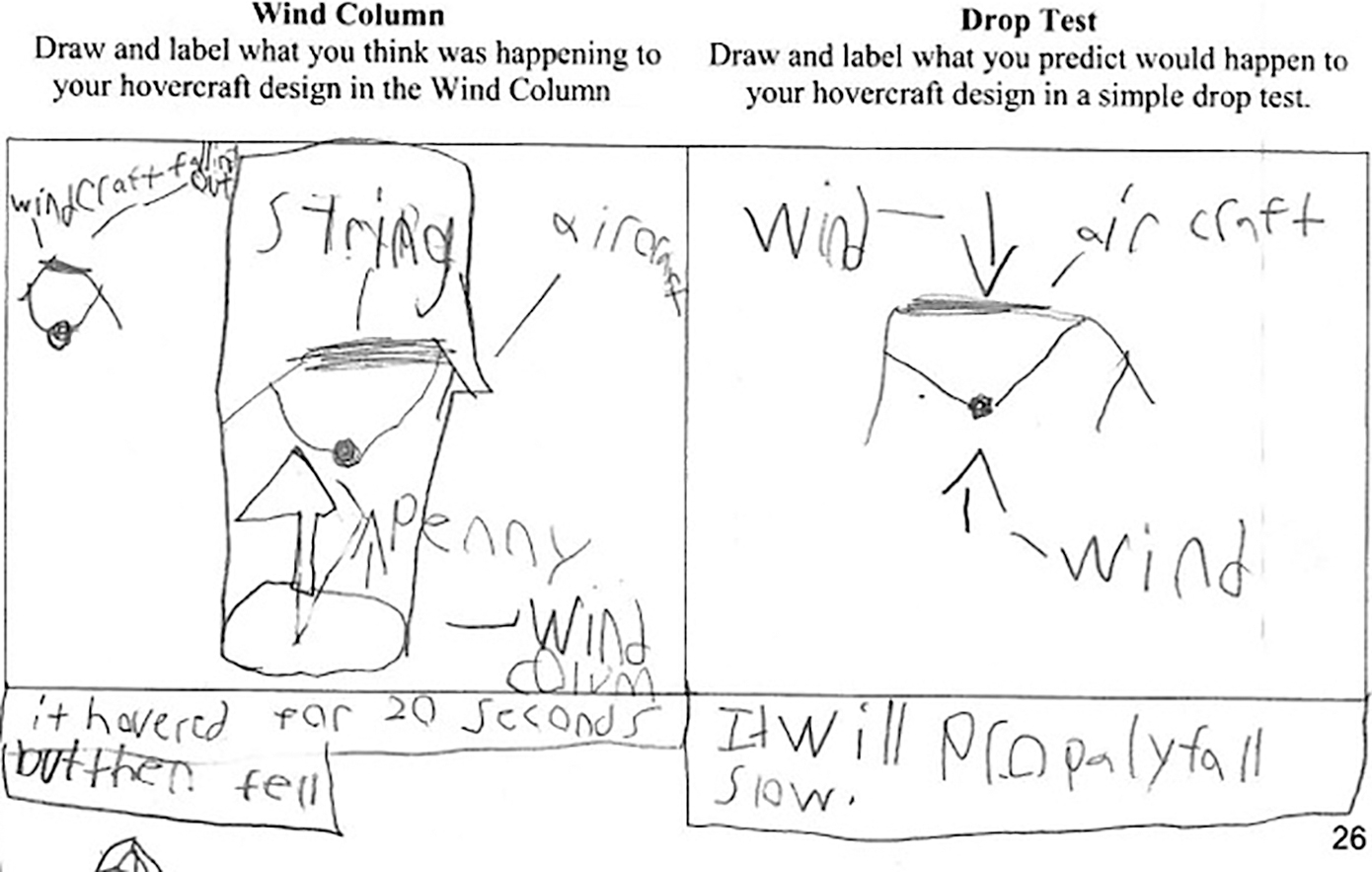
Students indicate forces with arrows.
After making their predictions, students received the blueprints of their final field trip designs. They traded designs with the person sitting next to them and were tasked with constructing their classmate’s design from the blueprint to the best of their ability. This design, while initially developed to hover in a wind column, was then tested to see how it performed when dropped in comparison to a plain washer. After testing, the students shared observations and compared them to their predictions. They then applied what they had learned from the first two classroom activities and modified their classmate’s design to further slow the rate of fall. During these improvements, students were encouraged to perform drop tests and iteratively change their design until the slowest falling design was discovered. Following this testing period, several students shared the modifications that they made, their reasoning for these changes, and what they found when they changed the design. The teachers wrapped up the discussion, focusing on two main points contrasting the activities: “For the drop test challenge, we designed something that would prevent the force of gravity from pulling the washer down fast; it was designed to maximize the force of air pushing up against it as it fell. For the wind column challenge, we designed something that would balance the force of gravity with the force of the air pushing up; it was designed to stay in one place as rising air moved past it.”
Assessment
In addition to monitoring student learning throughout the module, teachers assessed student knowledge by using pre- and post-assessments that asked students to apply their knowledge of forces in motion to falling leaves. This assessment invited students to apply their learning from the field trip model to a real-life phenomenon that they encounter every day. One teacher remarked that she “thought it was really valuable because they were noticing just the different shapes and sizes and the weight and observing different things so that was a perfect tie-in into the parachute creation because you’re looking at different features and it was…much more real world.” Figure 5 shows key ideas teachers should be looking for to show an understanding of key concepts from the unit.
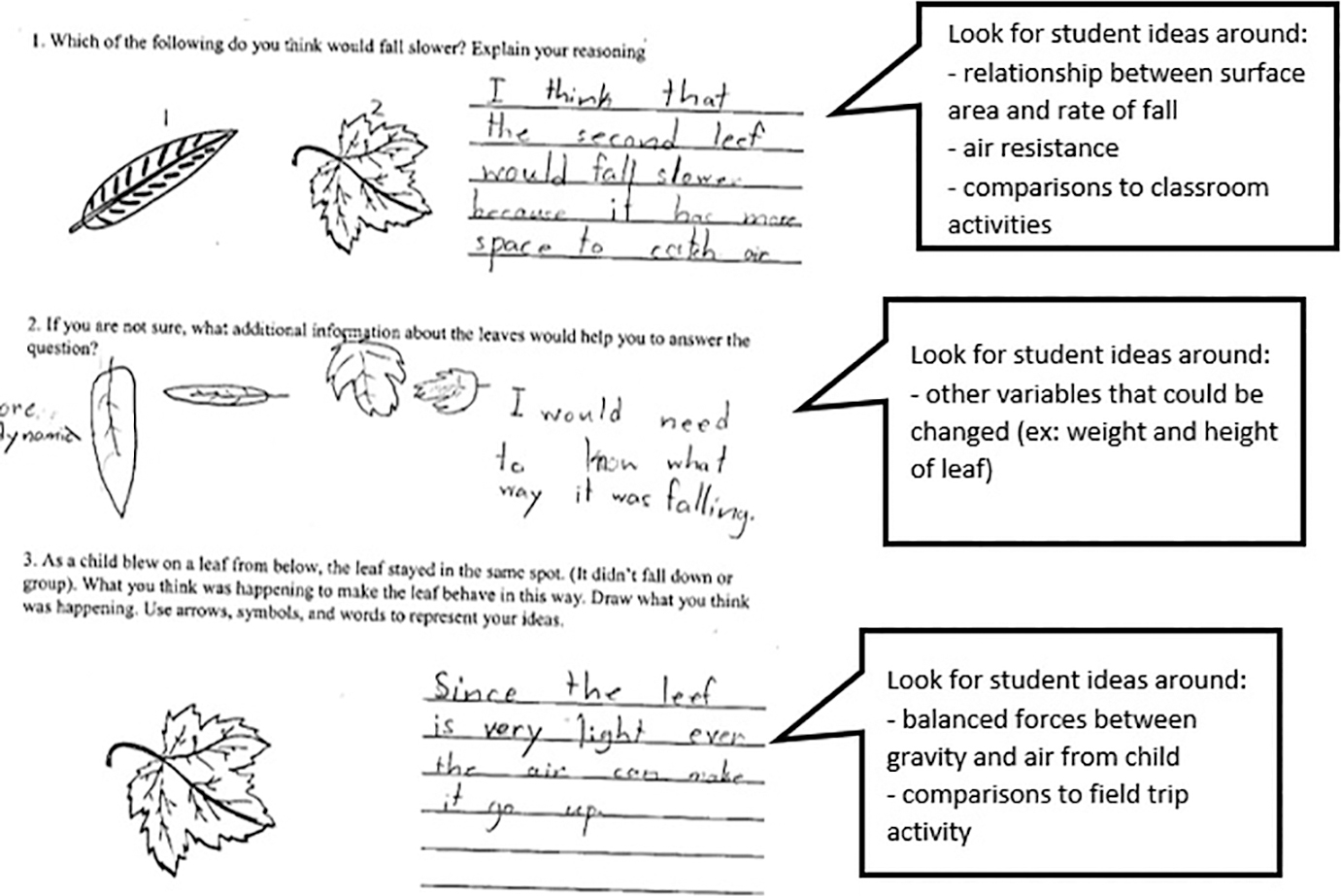
Assessment
This four-part module for extending the learning from a field trip into the classroom aligns with existing research around field trip learning, as it provided many benefits for the students when learning science and engineering (Bell et al. 2009; Farmer and Wott 1995). Throughout this module, students were introduced to the idea of forces and motion across different environments as well as the engineering design process. One teacher remarked that the “kids were engaged. They got exposure to things that they may not have before, especially as far as trying to improve upon something that they previously had started working on or their ideas that they had.” Another teacher remarked that this module “was 100% valuable and I found connections to previous grades and future grades and what we’re doing now” in regard to math, literacy and science standards. When remarking on how this curriculum fit with second language learners and students with IEP’s, one teacher remarked, “I noticed even with my [students with disabilities that they were all involved. They were talking and comprehending at whatever level they could.” In addition to being beneficial for engagement of all students, we have observed differences between the creativity of designs and willingness to iterate upon their designs between students who participate in the classroom activities and those who only participate in the field trip. Extending field trips into the classroom enhances student learning and helps students become comfortable with the engineering design process.
We understand that under current pandemic conditions, field trips may not currently be possible for schools or museums; however, this four-part module structure can be adapted for any extended learning around an engineering design challenge within the classroom, virtually, or at home. The classroom activities are already designed to be conducted with materials that teachers or families may have access to in classrooms or at home. The field trip activity could be replaced by asking students to design a vehicle that would land within a specified area when dropped in a moving air such as that created by a fan. Alternatively, the challenge could be replaced by asking students to apply the same ideas to a different environment, such as building a vehicle that falls slowly in water. Being able to engage in the engineering design process over an extended period of time regardless of location is important to support students’ success in engineering.
Acknowledgment
This material is based upon work supported by the National Science Foundation under Grants EEC-1824856 and EEC-1824859.
Alexandria Muller (Almuller@ucsb.edu) is a graduate student at the University of California, Santa Barbara. Tarah Connolly is a curriculum specialist, and Ron Skinner is a director of education, both at MOXI, The Wolf Museum of Exploration + Innovation in Santa Barbara, California. Danielle Harlow is a professor at the University of California, Santa Barbara.


